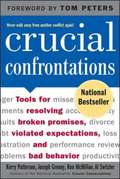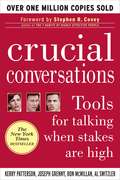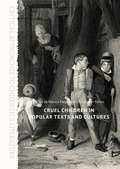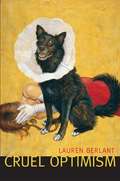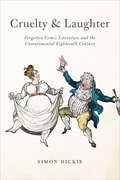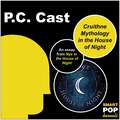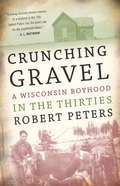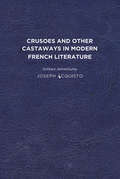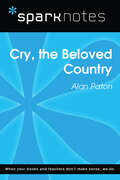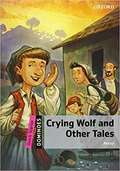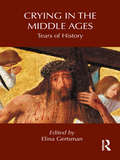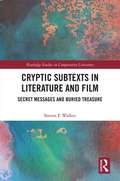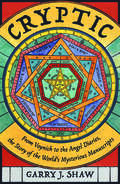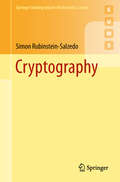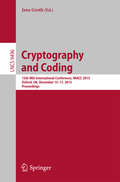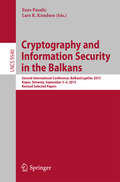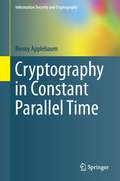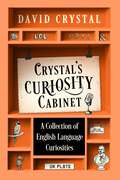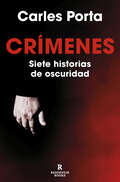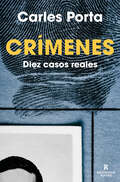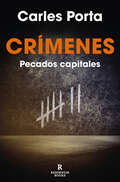- Table View
- List View
Crucial Confrontations: Tools for Resolving Broken Promises, Violated Expectations, and Bad Behavior
by Kerry Patterson Joseph Grenny Ron Mcmillan Al Switzler Tom PetersThe authors of the New York Times bestseller Crucial Conversations show you how to achieve personal, team, and organizational success by healing broken promises, resolving violated expectations, and influencing good behavior Discover skills to resolve touchy, controversial, and complex issues at work and at home--now available in this follow-up to the internationally popular Crucial Conversations. Behind the problems that routinely plague organizations and families, you'll find individuals who are either unwilling or unable to deal with failed promises. Others have broken rules, missed deadlines, failed to live up to commitments, or just plain behaved badly--and nobody steps up to the issue. Or they do, but do a lousy job and create a whole new set of problems. Accountability suffers and new problems spring up. New research demonstrates that these disappointments aren't just irritating, they're costly--sapping organizational performance by twenty to fifty percent and accounting for up to ninety percent of divorces. Crucial Confrontations teaches skills drawn from 10,000 hours of real-life observations to increase confidence in facing issues like: An employee speaks to you in an insulting tone that crosses the line between sarcasm and insubordination. Now what? Your boss just committed you to a deadline you know you can't meet--and not-so-subtly hinted he doesn't want to hear complaints about it. Your son walks through the door sporting colorful new body art that raises your blood pressure by forty points. Speak now, pay later. An accountant wonders how to step up to a client who is violating the law. Can you spell unemployment? Family members fret over how to tell granddad that he should no longer drive his car. This is going to get ugly. A nurse worries about what to say to an abusive physician. She quickly remembers "how things work around here" and decides not to say anything. Everyone knows how to run for cover, or if adequately provoked, step up to these confrontations in a way that causes a real ruckus. That we have down pat. Crucial Confrontations teaches you how to deal with violated expectations in a way that solves the problem at hand, and doesn't harm the relationship--and in fact, even strengthens it. Crucial Confrontations borrows from twenty years of research involving two groups. More than 25,000 people helped the authors identify those who were most influential during crucial confrontations. They spent 10,000 hours watching these people, documented what they saw, and then trained and tested with more than 300,000 people. Second, they measured the impact of crucial confrontations improvements on organizational and team performance--the results were immediate and sustainable: twenty to fifty percent improvements in measurable performance.
Crucial Conversations: Tools for Talking When Stakes Are High
by Stephen R. Covey Kerry Patterson Joseph Grenny Ron Mcmillan Al SwitzlerFour cofounders of a corporate consulting firm present their formula for effective communication, based on the trial and error of years spent as corporate trainers. The reader is drilled not only in communication skills but also to recognize bad or shifty modes of communication, to develop integrity in word and deed, and to achieve more effective work habits. Annotation c. Book News, Inc., Portland, OR (booknews.com)
Cruel Children in Popular Texts and Cultures (Critical Approaches to Children's Literature)
by Christopher Parkes Monica FlegelThis book explores how alarmist social discourses about 'cruel' young people fail to recognize the complexity of cruelty and the role it plays in child agency. Examining representations of cruel young people in popular texts and popular culture, the collected essays demonstrate how gender, race, and class influence who gets labeled 'cruel' and which actions are viewed as negative, aggressive, and disruptive. It shows how representations of cruel young people negotiate the violence that shadows polite society, and how narratives of cruelty and aggression are used to affirm, or to deny, young people’s agency.
Cruel Optimism
by Lauren BerlantA relation of cruel optimism exists when something you desire is actually an obstacle to your flourishing. Offering bold new ways of conceiving the present, Lauren Berlant describes the cruel optimism that has prevailed since the 1980s, as the social-democratic promise of the postwar period in the United States and Europe has retracted. People have remained attached to unachievable fantasies of the good life--with its promises of upward mobility, job security, political and social equality, and durable intimacy--despite evidence that liberal-capitalist societies can no longer be counted on to provide opportunities for individuals to make their lives "add up to something."Arguing that the historical present is perceived affectively before it is understood in any other way, Berlant traces affective and aesthetic responses to the dramas of adjustment that unfold amid talk of precarity, contingency, and crisis. She suggests that our stretched-out present is characterized by new modes of temporality, and she explains why trauma theory--with its focus on reactions to the exceptional event that shatters the ordinary--is not useful for understanding the ways that people adjust over time, once crisis itself has become ordinary. Cruel Optimism is a remarkable affective history of the present.
Cruelty & Laughter: Forgotten Comic Literature and the Unsentimental Eighteenth Century
by Simon DickieEighteenth-century British culture is often seen as polite and sentimental—the creation of an emerging middle class. Simon Dickie disputes these assumptions in Cruelty and Laughter, a wildly enjoyable but shocking plunge into the forgotten comic literature of the age. Beneath the surface of Enlightenment civility, Dickie uncovers a rich vein of cruel humor that forces us to recognize just how slowly ordinary human sufferings became worthy of sympathy.Delving into an enormous archive of comic novels, jestbooks, farces, variety shows, and cartoons, Dickie finds a vast repository of jokes about cripples, blind men, rape, and wife-beating. Epigrams about syphilis and scurvy sit alongside one-act comedies about hunchbacks in love. He shows us that everyone—rich and poor, women as well as men—laughed along. In the process, Dickie also expands our understanding of many of the century’s major authors, including Samuel Richardson, Lady Mary Wortley Montagu, Tobias Smollett, Frances Burney, and Jane Austen. He devotes particular attention to Henry Fielding’s Joseph Andrews, a novel that reflects repeatedly on the limits of compassion and the ethical problems of laughter. Cruelty and Laughter is an engaging, far-reaching study of the other side of culture in eighteenth-century Britain.
Cruelty and Laughter: Forgotten Comic Literature and the Unsentimental Eighteenth Century
by Simon DickieEighteenth-century British culture is often seen as polite and sentimental--the creation of an emerging middle class. Simon Dickie disputes these assumptions in Cruelty and Laughter, a wildly enjoyable but shocking plunge into the forgotten comic literature of the age. Beneath the surface of Enlightenment civility, Dickie uncovers a rich vein of cruel humor that forces us to recognize just how slowly ordinary human sufferings became worthy of sympathy. Delving into an enormous archive of comic novels, jestbooks, farces, variety shows, and cartoons, Dickie finds a vast repository of jokes about cripples, blind men, rape, and wife-beating. Epigrams about syphilis and scurvy sit alongside one-act comedies about hunchbacks in love. He shows us that everyone--rich and poor, women as well as men--laughed along. In the process, Dickie also expands our understanding of many of the century's major authors, including Samuel Richardson, Lady Mary Wortley Montagu, Tobias Smollett, Frances Burney, and Jane Austen. He devotes particular attention to Henry Fielding's Joseph Andrews, a novel that reflects repeatedly on the limits of compassion and the ethical problems of laughter. Cruelty and Laughter is an engaging, far-reaching study of the other side of culture in eighteenth-century Britain.
Cruithne Mythology and the House of Night
by PC CastFrom Nyx in the House of Night: Mythology, Folklore, and Religion in the P.C. and Kristin Cast Vampyre Series: P.C. Cast relates her inspiration for the setting of the House of Night and how Scottish and Irish history are woven into the series.
Crunching Gravel: A Wisconsin Boyhood in the Thirties
by Robert PetersNo nostalgic tale of the good old days, Robert Peters’s recollections of his adolescence vividly evoke the Depression on a hardscrabble farm near Eagle River: Dad driving the Vilas County Relief truck, Lars the Swede freezing to death on his porch, the embarassment of graduation in a suit from welfare. The hard efforts to put fish and potatoes and blueberries on the table are punctuated by occasional pleasures: the Memorial Day celebration, swimming at Perch Lake, the county fair with Mother’s prizes for jam and the exotic delights of the midway. Peters’s clear-eyed memoir reveals a poet’s eye for rich and stark detail even as a boy of twelve. “Peters misses nothing, from the details of the town’s Fourth of July celebration to the cause and effect of a young cousin’s suicide to the calibrations of racism toward Indians that was so acceptable then. It is a fascinating, unsentimental look at a piece of our past. ”—Margaret E. Guthrie,New York Times Book Review “It’s unlikely that any other contemporary poet and scholar as distinguished has risen from quite so humble beginnings as Robert Peters. Born and raised by semiliterate parents on a subsistence farm in northeastern Wisconsin, Peters lived harrowingly close to the eventual stuff of his poetry—the dependency of humans on animal lives, the inexplicable and ordinary heroism and baseness of people facing extreme conditions, the urgency of physical desire. . . . Sterling childhood memoirs. ”—Booklist “Robert Peters has written a memoir exemplary because he insists on the specific, on the personal and the local. It is also enormously satisfying to read, and it is among the most authentic accounts of childhood and youth I know—a Wisconsin David Copperfield!”—Thom Gunn
Crusoes and Other Castaways in Modern French Literature: Solitary Adventures
by Joseph AcquistoCrusoes and Other Castaways in Modern French Literature: Solitary Adventures by Joseph Acquisto examines the many ways in which the castaway, particularly in the form of engagement with Robinson Crusoe, has been reinterpreted and appropriated in nineteenth through twenty-first century French literature. The book is not merely a literary history of the robinsonnade in France; rather, Acquisto demonstrates how what he calls the genre of “solitary adventure” becomes a vehicle for exploration of much larger questions about the reception of texts, modes of reading, and the relationship between popular and serious literary traditions. The heart of Crusoes and Other Castaways in Modern French Literature examines a crucial moment in the late nineteenth and early twentieth centuries when the history of cultural perspectives on reading and solitude intersect, catalyzing a reconsideration of Defoe’s tale. Acquisto’s philosophically inflected readings of works by writers from Rousseau to Balzac, Verne to Gide, Valéry to Tournier enhance intertextual and cultural approaches to the castaway myth and broaden our appreciation of the dynamic relation it has to modern French literature writ large. Published by University of Delaware Press. Distributed worldwide by Rutgers University Press.
Cry, the Beloved Country (SparkNotes Literature Guide Series)
by SparkNotesCry, the Beloved Country (SparkNotes Literature Guide) by Alan Paton Making the reading experience fun! Created by Harvard students for students everywhere, SparkNotes is a new breed of study guide: smarter, better, faster.Geared to what today's students need to know, SparkNotes provides:chapter-by-chapter analysis explanations of key themes, motifs, and symbols a review quiz and essay topics Lively and accessible, these guides are perfect for late-night studying and writing papers.
Crying Wolf and Other Tales
by Janet Hardy-GouldCrying Wolf (Part 1 & 2); The Goose with the Golden Eggs (Part 1 & 2); The Bear and the Two Travelers (Part 1 & 2).
Crying in the Middle Ages: Tears of History (Routledge Studies in Medieval Religion and Culture)
by Elina GertsmanSacred and profane, public and private, emotive and ritualistic, internal and embodied, medieval weeping served as a culturally charged prism for a host of social, visual, cognitive, and linguistic performances. Crying in the Middle Ages addresses the place of tears in Jewish, Christian, and Islamic cultural discourses, providing a key resource for scholars interested in exploring medieval notions of emotion, gesture, and sensory experience in a variety of cultural contexts. Gertsman brings together essays that establish a series of conversations with one another, foregrounding essential questions about the different ways that crying was seen, heard, perceived, expressed, and transmitted throughout the Middle Ages. In acknowledging the porous nature of visual and verbal evidence, this collection foregrounds the necessity to read language, image, and experience together in order to envision the complex notions of medieval crying.
Cryptic Subtexts in Literature and Film: Secret Messages and Buried Treasure
by Steven F WalkerOne of the primary objectives of comparative literature is the study of the relationship of texts, also known as intertextuality, which is a means of contextualizing and analyzing the way literature grows and flourishes through inspiration and imitation, direct or indirect. When the inspiration and imitation is direct and obvious, the study of this rapport falls into the more restricted category of hypertextuality. What the author has labeled a cryptic subtext, however, is an extreme case of hypertextuality. It involves a series of allusions to another text that have been deliberately inserted by the author into the primary text as potential points of reference. This book takes a deep dive into a broad array of literature and film to explore these allusions and the hidden messages therein.
Cryptic: From Voynich to the Angel Diaries, the Story of the World's Mysterious Manuscripts
by Garry J. ShawAn absorbing history of Europe&’s nine most puzzling texts, including the biggest mystery of all: the Voynich Manuscript Books can change the world. They can influence, entertain, transport, and enlighten. But across the centuries, authors have disguised their work with codes and ciphers, secret scripts and magical signs. What made these authors decide to keep their writings secret? What were they trying to hide? Garry J. Shaw tells the stories of nine puzzling European texts. Shaw explores the unknown alphabet of the nun Hildegard of Bingen; the enciphered manuscripts of the prank-loving physician Giovanni Fontana; and the angel communications of the polymath John Dee. Along the way, we discover how the pioneers of science and medicine concealed their work, encounter demon magic and secret societies, and delve into the intricate symbolism of alchemists searching for the Philosopher&’s Stone. This highly enjoyable account takes readers on a fascinating journey through Europe&’s most cryptic writings—and attempts to shed new light on the biggest mystery of all: the Voynich Manuscript.
Cryptography (Springer Undergraduate Mathematics Ser.)
by Simon Rubinstein-SalzedoThis text introduces cryptography, from its earliest roots to cryptosystems used today for secure online communication.Beginning with classical ciphers and their cryptanalysis, this book proceeds to focus on modern public key cryptosystems such as Diffie-Hellman, ElGamal, RSA, and elliptic curve cryptography with an analysis of vulnerabilities of these systems and underlying mathematical issues such as factorization algorithms. Specialized topics such as zero knowledge proofs, cryptographic voting, coding theory, and new research are covered in the final section of this book.Aimed at undergraduate students, this book contains a large selection of problems, ranging from straightforward to difficult, and can be used as a textbook for classes as well as self-study. Requiring only a solid grounding in basic mathematics, this book will also appeal to advanced high school students and amateur mathematicians interested in this fascinating and topical subject.
Cryptography and Coding: 15th IMA International Conference, IMACC 2015, Oxford, UK, December 15-17, 2015. Proceedings (Lecture Notes in Computer Science #9496)
by Jens GrothThis book constitutes the proceedings of the 15th IMA International Conference on Cryptography and Coding, IMACC 2015, held at Oxford, UK, in December 2015. The 18 papers presented together with 1 invited talk were carefully reviewed and selected from 36 submissions. The scope of the conference was on following topics: authentication, symmetric cryptography, 2-party computation, codes, Boolean functions, information theory, and leakage resilience.
Cryptography and Information Security in the Balkans: Second International Conference, BalkanCryptSec 2015, Koper, Slovenia, September 3-4, 2015, Revised Selected Papers (Lecture Notes in Computer Science #9540)
by Enes Pasalic Lars R. KnudsenThis book contains revised selected papers fromthe Second International Conference on Cryptology and Information Security inthe Balkans, BalkanCryptSec 2015, held in Koper, Slovenia, in September 2015. The 12 papers presented inthis volume were carefully reviewed and selected from 27 submissions. They areorganized in topical sections named: symmetric key cryptography; cryptanalysis;security and protocols; and implementation and verifiable encryption.
Cryptography and Secure Communication
by Richard E. BlahutToday's pervasive computing and communications networks have created an intense need for secure and reliable cryptographic systems. Bringing together a fascinating mixture of topics in engineering, mathematics, computer science, and informatics, this book presents the timeless mathematical theory underpinning cryptosystems both old and new. Major branches of classical and modern cryptography are discussed in detail, from basic block and stream cyphers through to systems based on elliptic and hyperelliptic curves, accompanied by concise summaries of the necessary mathematical background. Practical aspects such as implementation, authentication and protocol-sharing are also covered, as are the possible pitfalls surrounding various cryptographic methods. Written specifically with engineers in mind, and providing a solid grounding in the relevant algorithms, protocols and techniques, this insightful introduction to the foundations of modern cryptography is ideal for graduate students and researchers in engineering and computer science, and practitioners involved in the design of security systems for communications networks.
Cryptography in Constant Parallel Time (Information Security and Cryptography)
by Benny ApplebaumLocally computable (NC0) functions are "simple" functions for which every bit of the output can be computed by reading a small number of bits of their input. The study of locally computable cryptography attempts to construct cryptographic functions that achieve this strong notion of simplicity and simultaneously provide a high level of security. Such constructions are highly parallelizable and they can be realized by Boolean circuits of constant depth. This book establishes, for the first time, the possibility of local implementations for many basic cryptographic primitives such as one-way functions, pseudorandom generators, encryption schemes and digital signatures. It also extends these results to other stronger notions of locality, and addresses a wide variety of fundamental questions about local cryptography. The author's related thesis was honorably mentioned (runner-up) for the ACM Dissertation Award in 2007, and this book includes some expanded sections and proofs, and notes on recent developments. The book assumes only a minimal background in computational complexity and cryptography and is therefore suitable for graduate students or researchers in related areas who are interested in parallel cryptography. It also introduces general techniques and tools which are likely to interest experts in the area.
Cryptography: A Very Short Introduction
by Fred Piper Sean MurphyProvide information about cryptography, gives tips and techniques.
Crystallized Memories: Award Winning Telugu Essays
by M. V. Chalapathi Rao Cekuri Rama RaoCrystallized Memories is the translation of Chekuri Rama Rao's Smriti Kinankam.
Crystal’s Curiosity Cabinet: An English Language Miscellany
by David CrystalWhat do a comic alphabet, a glorious lipogram and a wellerism have in common? Or, an audit of accountants, an illusion of magicians, and an intrusion of spammers? And do you know how Shakespeare pronounced his name?Quirky, original, amusing and enlightening, this charming English Language Miscellany from David Crystal, one of the greatest British linguists of our time, offers fascinating observations on random, weird and witty words and expressions, collected over a number of years.Following the tradition of the Victorian miscellany and cabinets of curiosities, the 150+ random entries reveal the global, national, contemporary and historical impact of language, and will appeal to word lovers and fun-fact-fiends alike.Showcasing linguistic creativity in all its glory, and featuring a wide range of topics that reflect current language issues, such as accents, dialects, etymology, proverbs, place names, punctuation, everyday usage, and language change, this book provides a playful, entertaining and informative read on the bizarre nature of language.
Crímenes. Siete historias de oscuridad: Incluye el crimen de la Guardia Urbana (Crímenes #Volumen 1)
by Carles PortaLos crímenes reales más increíbles, como jamás te los han contado.Por el creador de ¿Por qué matamos? y Crims/Crímenes ***INCLUYE EL CRIMEN DE LA GUARDIA URBANA*** Carles Porta es el narrador de crímenes más singular del panorama nacional. Sus historias son estremecedoras sin amarillismo, frías pero delicadas, apasionantes sin caer en lo morboso. En este volumen se reúnen siete crónicas narradas con ritmo experto y rigor documental, la marca del éxito de su autor.Entre ellas, destacan el crimen de la Viuda Negra de L’Hospitalet, que en los años noventa fue definida como «la asesina en serie por envenenamiento más importante de la historia criminal española»; el caso del rico informático catalán descuartizado en Bangkok; la historia del camionero alemán que, en sus viajes por Europa, fue dejando un rastro de muerte a largo de veinte países; o el célebre caso de la Guardia Urbana, en el que las intrincadas declaraciones de los protagonistas van conformado un relato donde la realidad supera a la ficción.Como colofón, esta edición incluye también los guiones completos de la miniserie El Crimen de la Guardia Urbana, emitida en TV3 y Movistar+, donde asistimos al desenlace final de uno de los sucesos más mediáticos de la historia reciente de nuestro país. La crítica ha dicho:«Hoy, Porta es el capo del true crime en España».Antonio Rivera, Esquire «Periodismo en profundidad, y próximo».La Vanguardia «El rey del true crime en España».Sara Polo, El Mundo«El desafío de contar historias respetuosamente. […] Sin duda, Carles Porta se ha convertido en un maestro de la narración de crímenes reales en el mundo de los medios modernos».Laura Pérez Mariño, Qué! ...Sobre Crímenes. Pecados capitales:«El fenómeno Crímenes no tiene límites y ha convertido a Carles Porta en un icono pop: su forma de abordar un tema tan delicado como los crímenes, rigiéndose siempre por el principios de las tres erres «rigor informativo, respeto y ritmo narrativo», busca evitar el amarillismo y no generar más morbo».El Periódico ...Sobre Crímenes. Diez casos reales:«Su especialidad literaria: contarnos extraordinarias historias de crimen y trabajo policial mientras nos mantiene en vilo hasta la última línea».La Razón«La crónica negra de toda la vida, pero narrada como nunca».ABC ...Sobre La farmacéutica:«Se lee todo del tirón y uno no da crédito a que sucediera de verdad. [...] Crónica definitiva de aquel secuestro, es un libro de lectura muy dinámica».El Mundo «Este libro pone orden y claridad a los acontecimientos: Porta narra con dinamismo y rellena todos los agujeros con tal de revertir los malentendidos que circulan en la esfera pública».El País «Una especie de Fargo en la Garrotxa».Diari de Girona
Crímenes: Diez casos reales
by Carles Porta*****INCREÍBLEMENTE REAL***** El periodismo literario de Carles Porta sigue la estela de Ferdinand von Schirach y Patrick Radden Keefe. Carles Porta probablemente sea uno de nuestros mejores periodistas, pero sin duda se ha coronado, con sus libros, podcasts y series televisivas, como un magistral narrador de relatos reales. En este volumen, que recoge diez de los casos más impactantes de la crónica negra reciente, descubriremos su especialidad literaria: contarnos extraordinarias historias de crimen y trabajo policial mientras nos mantiene en vilo hasta la última línea. La fórmula puede parecer sencilla, pero él la convierte en inimitable gracias al tratamiento riguroso que hace de los grandes personajes que escoge y la manera en que los sabe envolver en tramas tan potentes como verídicas. Aquí encontraremos, entre otros: el caso de Amaia Azkue, la vecina de Zarautz cuyo asesino fue identificado por un detalle trivial; la estremecedora desaparición de los hermanos Òrrit en el hospital de Manresa y la búsqueda que ha llevado a cabo durante décadas su numerosa familia; el asesinato a sangre fría de un hombre en Madrid a causa de un macabro juego de rol; o el sangriento robo que cometió una mujer en Fargo, Dakota del Norte, contra su propia vecina. La crítica ha dicho:«El rey de la crónica negra en España.»El Mundo «Un profundo ejercicio de depuración de estilo.»ABC «Periodismo en profundidad, y próximo.»La Vanguardia «Combina el rigor y el entretenimiento sin caer en la tentación del morbo ni tampoco rehuir los anzuelos para propulsar la lectura.»El País La crítica ha dicho sobre La farmacéutica:«Se lee todo del tirón y uno no da crédito a que sucediera de verdad. [...] Crónica definitiva de aquel secuestro, es un libro de lectura muy dinámica.»El Mundo «Lo que realmente le gusta a Porta es contar buenas historias. [...] La última es un clásico de 1992, tiene como protagonista a una farmacéutica y la cuenta en un gran libro.»La Vanguardia «Un solo hilo narrativo que combina la vivacidad, el drama y la ironía, además de evidenciar la grandeza y, a su vez, la miseria humana. [...] Sin duda, con esta crónica, Porta se consagra, según los expertos del género, como un maestro del periodismo narrativo.»NacióDigital «Este libro pone orden y claridad a los acontecimientos: Porta narra con dinamismo y rellena todos los agujeros con tal de revertir los malentendidos que circulan en la esfera pública.»El País «Una crónica trepidante.»ABC «Una especie de Fargo en la Garrotxa.»Diari de Girona
Crímenes: pecados capitales
by Carles PortaVuelve Carles Porta, el creador de ¿Por qué matamos? y Crims/Crímenes,con su formato más adictivo: los crímenes reales más increíbles,como jamás te los han contado. «Combina el rigor y el entretenimiento sin caer en la tentación del morbo ni tampoco rehuir los anzuelos para propulsar la lectura».El País «El rey de la crónica negra en España».El Mundo Soberbia, avaricia, lujuria, ira, gula, envidia y pereza. Los siete pecados capitales. Descritos por Dante en la Divina comedia. Señalados por la tradición eclesiástica cristiana como el origen de los demás vicios. Son, sin duda, lacras que desde tiempos inmemoriales han arraigado en nuestra mente. ¿Podríamos imaginar al ser humano sin ellas? ¿Son estas las pasiones que mueven el mundo en que vivimos? ¿Por qué matamos? Las siete historias reales que leeréis tienen alguna de estas pasiones del alma como móvil del crimen: el secuestro de Mélodie Nakachian, en el ámbito de la jet set de la Costa del Sol en los años ochenta; el crimen del supermercado Esclat de Mollet del Vallès, con el apuñalamiento ensañado a un guardia de seguridad; la desaparición del bebé de una familia de Canovelles, cerca de Granollers, a la que poco antes había tocado el Gordo de Navidad; el caso Febamar en Alcanar, en el extremo sur de Catalunya, donde el propietario de un concesionario de coches y su mujer fueron víctimas de un asalto mortal; la crónica de cómo una intervención policial ordinaria destapó la tragedia siniestra del caníbal de Ventas, en Madrid; la historia del monje shaolín de Bilbao, que había convertido su gimnasio en un pozo de los horrores; y el asesinato, cerca de Figueres, de Isidre Matas, un hombre con muy mala suerte. La crítica ha dicho:«Un profundo ejercicio de depuración de estilo».ABC «Periodismo en profundidad, y próximo».La Vanguardia Sobre Crímenes. Diez casos reales:«Su especialidad literaria: contarnos extraordinarias historias de crimen y trabajo policial mientras nos mantiene en vilo hasta la última línea».La Razón«La crónica negra de toda la vida pero narrada como nunca».ABC «Un auténtico maestro en el arte de contar casos [...] siempre riguroso y prestando atención a todas las aristas, ya sean estas psicológicas, sociales, políticas o culturales. Historias inverosímiles que nunca creeríamos si no supiéramos que ocurrieron realmente».Men's HealthSobre La farmacéutica: «Se lee todo del tirón y uno no da crédito a que sucediera de verdad. [...] Crónica definitiva de aquel secuestro, es un libro de lectura muy dinámica».El Mundo «Este libro pone orden y claridad a los acontecimientos: Porta narra con dinamismoy rellena todos los agujeros con tal de revertir los malentendidos que circulan en la esfera pública».El País «Una especie de Fargo en la Garrotxa».Diari de Girona
